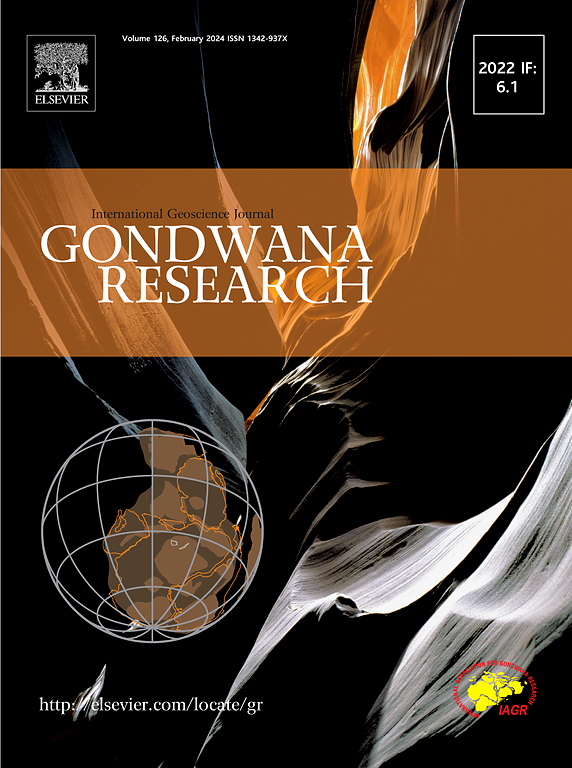基质类型驱动的界面微生物群落差异和致病风险:粘土、微塑料和活性炭
IF 7.2
1区 地球科学
Q1 GEOSCIENCES, MULTIDISCIPLINARY
引用次数: 0
摘要
本研究通过对天然蒙脱土(MMT)和人工基质(活性炭(AC)、聚丙烯(PP)和聚苯乙烯(PS))在地表水中的微生物定植、细菌群落和潜在风险进行了研究。生物膜生物量和多糖含量表明,微生物在不同底物上的定殖潜力依次为AC >;MMT祝辞页的在PS.高通量测序结果显示微生物选择性定殖于各种底物,形成独特的细菌群落。与人工基质相比,天然基质中微生物群落丰度较高,但多样性较低。此外,天然基质上的细菌群落表现出比人工基质更强的氮循环功能,而人工基质(尤其是微塑料)上的细菌群落表现出更强的碳循环功能,如芳烃降解和烃类降解。在不同底物中鉴定出细小单胞菌、少动鞘单胞菌、血副球菌等25种致病菌,MMT上的丰度高于其他底物。然而,微塑料上更多种类的致病菌与人类疾病有关,这意味着更高的环境风险。这些结果表明,天然基质和人工基质上的微生物群落组成和功能存在基质驱动的差异,表明在地表水中,人工基质的关注度低于具有相关生物膜的天然基质。本文章由计算机程序翻译,如有差异,请以英文原文为准。

Substrate type-driven differences in interfacial microbial community and pathogenic risk: Clay, microplastics and activated carbon
This study investigated the microbial colonization, bacterial community and potential risks in natural (montmorillonite (MMT)) and artificial substrates (activated carbon (AC), polypropylene (PP) and polystyrene (PS)) by microcosm incubations in surface water. Biofilm biomass and polysaccharide content indicate that the colonization potential of microbes on different substrates followed the order of AC > MMT > PP > PS. High-throughput sequencing results reveal that microbes selectively colonized various substrates and formed unique bacterial community. Compared to the artificial substrate, natural substrate enriched with high abundance but low diversity of microbial community. In addition, bacterial community on natural substrates exhibited stronger nitrogen cycling function than artificial substrates, whereas bacterial community on artificial substrates (especially microplastics) exhibited stronger carbon cycling functions, such as aromatic_compound_degradation and hydrocarbon_degradation. Also, Brevundimonas diminuta, Sphingomonas paucimobilis, Paracoccus sanguinis and other twenty-five species of pathogenic bacteria were identified in various substrates and their abundance was higher on MMT than on other substrates. However, many more species of pathogenic bacteria on microplastic are associated with human diseases, implying a higher environmental risk. These results indicated that microbial community composition and function on natural and artificial substrates exhibited substrate-driven differences, highlighting the lower concerns of artificial substrates than natural ones with associated biofilms in surface water.
求助全文
通过发布文献求助,成功后即可免费获取论文全文。
去求助
来源期刊

Gondwana Research
地学-地球科学综合
CiteScore
12.90
自引率
6.60%
发文量
298
审稿时长
65 days
期刊介绍:
Gondwana Research (GR) is an International Journal aimed to promote high quality research publications on all topics related to solid Earth, particularly with reference to the origin and evolution of continents, continental assemblies and their resources. GR is an "all earth science" journal with no restrictions on geological time, terrane or theme and covers a wide spectrum of topics in geosciences such as geology, geomorphology, palaeontology, structure, petrology, geochemistry, stable isotopes, geochronology, economic geology, exploration geology, engineering geology, geophysics, and environmental geology among other themes, and provides an appropriate forum to integrate studies from different disciplines and different terrains. In addition to regular articles and thematic issues, the journal invites high profile state-of-the-art reviews on thrust area topics for its column, ''GR FOCUS''. Focus articles include short biographies and photographs of the authors. Short articles (within ten printed pages) for rapid publication reporting important discoveries or innovative models of global interest will be considered under the category ''GR LETTERS''.
 求助内容:
求助内容: 应助结果提醒方式:
应助结果提醒方式:


